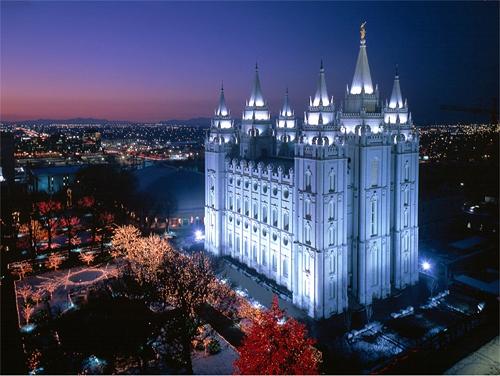Difference between revisions of "Mormon Temples"
(→Holiness to the Lord, the House of the Lord) |
|||
| Line 11: | Line 11: | ||
The Mormon Church dedicates all of its buildings to the worship of God and as places where the Holy Spirit can reside and bless and inspire those who enter. But unlike these other buildings, Mormon temples are dedicated to be the houses of the Lord: sacred, special, and set apart from the rest of the world. As Houses of the Lord, it is the Lord who sets the standard whereby people may enter. Those who enter the temple must do so worthily. Members must be keeping the commandments and hold what is known as a Mormon temple recommend, a card signed by the [[bishop]] and [[Stake President|stake president]] stating that the person is worthy. The Lord invites all men and women to become worthy come to the temple. | The Mormon Church dedicates all of its buildings to the worship of God and as places where the Holy Spirit can reside and bless and inspire those who enter. But unlike these other buildings, Mormon temples are dedicated to be the houses of the Lord: sacred, special, and set apart from the rest of the world. As Houses of the Lord, it is the Lord who sets the standard whereby people may enter. Those who enter the temple must do so worthily. Members must be keeping the commandments and hold what is known as a Mormon temple recommend, a card signed by the [[bishop]] and [[Stake President|stake president]] stating that the person is worthy. The Lord invites all men and women to become worthy come to the temple. | ||
| − | [[Inside Mormon temples|In the temple]] faithful members of the LDS Church perform [[Ordinances|ordinances]] essential to the salvation of mankind and enter into covenants with the Lord. The temple is like a school where men and women learn about sacred and eternal things. The temple can be considered as a presentation, in figurative terms, of the pattern and journey of life on earth, often referred to as the [[Plan of Salvation]]. In | + | [[Inside Mormon temples|In the temple]] faithful members of the LDS Church perform [[Ordinances|ordinances]] essential to the salvation of mankind and enter into covenants with the Lord. The temple is like a school where men and women learn about sacred and eternal things. The temple can be considered as a presentation, in figurative terms, of the pattern and journey of life on earth, often referred to as the [[Plan of Salvation]]. In Mormon temples, holy truths are taught and solemn covenants are made not only by the individual members on their own behalf, but also on behalf of others who have died. |
== Mormon Temples and Work for the Dead== | == Mormon Temples and Work for the Dead== | ||
Revision as of 21:52, 3 February 2014

The work performed in holy temples, a work restored to the earth by ministering angels under the direction of God the Father and His son, Jesus Christ, sets The Church of Jesus Christ of Latter-day Saints (Mormon Church) apart from the rest of the contemporary Christian world.
The Church currently has 129 temples in operation in over 40 countries around the world. Seventeen more have been announced or are already under construction. Of those in operation, over 60% have been dedicated during the last decade (See Chronological List of Temples). The exponential growth in the number of Mormon temples coincides with the tremendous growth of the Church around the world. President Gordon B. Hinckley (who has himself dedicated or re-dedicated over 80 temples) has done much to spread the blessings of the temple to members. Said he: "We have done all that we know how to do to bring temples closer to our people. There are still many who have to travel long distances. I hope they will continue to make that effort" (“Closing Remarks,” Ensign, Nov. 2004, 104).
Holiness to the Lord, the House of the Lord
According to one Church leader, "Each holy temple stands as a symbol of our membership in the Church, as a sign of our faith in life after death, and as a sacred step toward eternal glory for us and our families" (Russell M. Nelson, “Personal Preparation for Temple Blessings,” Ensign, May 2001, 32)
The Mormon Church dedicates all of its buildings to the worship of God and as places where the Holy Spirit can reside and bless and inspire those who enter. But unlike these other buildings, Mormon temples are dedicated to be the houses of the Lord: sacred, special, and set apart from the rest of the world. As Houses of the Lord, it is the Lord who sets the standard whereby people may enter. Those who enter the temple must do so worthily. Members must be keeping the commandments and hold what is known as a Mormon temple recommend, a card signed by the bishop and stake president stating that the person is worthy. The Lord invites all men and women to become worthy come to the temple.
In the temple faithful members of the LDS Church perform ordinances essential to the salvation of mankind and enter into covenants with the Lord. The temple is like a school where men and women learn about sacred and eternal things. The temple can be considered as a presentation, in figurative terms, of the pattern and journey of life on earth, often referred to as the Plan of Salvation. In Mormon temples, holy truths are taught and solemn covenants are made not only by the individual members on their own behalf, but also on behalf of others who have died.
